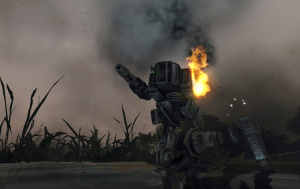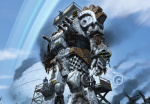Combat Guide
Welcome to the MechWarrior: Living Legends Combat Guide!
This tutorial will lead you through the many aspects of combat in MWLL, as here you will find essential information and various hints regarding combat. This guide is intended to be a relatively general overview and will not go too deep into details of specific match-ups.
Sooner or later, you will get into a battle of some kind. As a new player, your first few battles are likely to be chaotic, with all sorts of things happening at once. (?)
--> have some sort of actual opener of some kind. points is far better off as an article unto itself, given its prominence as a gameplay concept. a couple sentences wouldn't hurt though.
--> otherwise, talk more about _how_ to fight: IDing targets, the importance of checking paperdolls for damage/weak areas, arm/torso blocking, "can I win this fight", when to run, general areas to shoot at
Contents
Know Thy Enemy
Knowing what your potential opponents are capable of is necessary to figuring out how to beat them. Most 'Mechs and some vehicles have visually distinct variants, so a visual identification of the exact variant a player has is often possible with some exposure to the particular silhouettes of common variants. This lets you do two things: first, it lets you understand the precise capabilities of the target. Second, you can then determine whether the target is a threat or not.
Checking the opponent's current armor status is also very helpful, when possible. This will reveal whether they have already suffered damage and which locations you should target to secure a quick victory.
From here, you can make an informed decision whether to engage, fall back, stand your ground or another course of action, depending on the specific circumstances.
Know Thyself
Armor, Accuracy, Damage

Nearly every target (exception being BAs and base defense turrets) have multiple components, each with separate armor. To destroy a unit at least one critical component needs to be destroyed. The critical components are:
- For Mechs:
- Center Torso and Back Torso
- For Vehicles:
- Hull (which can only be destroyed by first destroying the armor plating protecting a specific hitbox)
- For VTOL & Aerospace:
- Body, Engine
All the other components play an additional role. Destroying them will weaken but not destroy the vehicle in question. Tanks can drive without a turret, though any more damage to the turret will be redirected to all its other components. Aerospace with a wing shot off will remain in the air for as long as it takes for gravity to pull it down to the ground, though the pilot loses control over it. A Mech missing one of its legs will tumble to the ground, making it an easy target. A legged Mech can still rotate its torso, use Jump Jets, and - should it still be facing them - shoot at its opponents.
The fastest way to destroy your target is to deal as much damage as possible to one of its key components. This allows quick removal of opponents and high score rewards. If possible, aim for a 'Mech's back torso, as there is less armor than on the front and damaging/destroying the back torso will cripple your opponent, making them easier to bring down.
For more information about the effects of damage, see the Armor article.
Weapons
It is challenging to fight well when uncertain about what each weapon is and what it is best suited for. Take some time and read over the Weapons tables to learn more about all of the weapons available in MWLL. The testing centre servers also give you a place to see what each weapon does.
In a nutshell, when buying an asset, knowing the advantages and disadvantages of its loadout and using it toward victory is crucial. An opponent, especially an experienced one, will try to use the disadvantages of your unit - if your main weapons are LRMs, they will try to slip within the minimum range of your missiles. Conversely, an opponent will stand back and snipe you if all your weapons are short-ranged.
For more information about picking assets, check out either the Asset Bible or the Starter Asset Guide for a more in-depth look at early-game assets.
Grouping & Fire Modes
The importance of configuring your weapons properly cannot be understated, especially since the default weapon groupings often put a lot of different weapons on one trigger, causing unnecessary heat buildup or a loss of potential damage. You can configure your own weapon groupings using the arrow keys to select a weapon and group, then pressing Enter to assign/unassign that weapon from the selected group.
Most of the time, you will want to group weapons with similar range profiles and properties together. Let's use the Mad Cat Prime as an example:
- On your first trigger, group both your ERLBLs on their own. They are your main precision long-range weapons and will often be used to fire on anything you see when you can handle the heat output.
- Next, consider grouping both your LRM20 packs together. Being missile weapons, you will want to fire these only when you have lock and a clear view of your opponent.
- For the third group, assign both your ERMBLs. You can also put the MPL on this trigger if you want, although you will be generating a fair bit of excess heat for no reason when firing at targets beyond 500m.
- Last, place your two MGs on the fourth trigger. You can also assign the MPL to this group. This weapons group can be used when fighting Battle Armor or to provide additional damage in a brawl.
Some 'Mechs with a large number of identical energy weapons, such as the Puma C or Masakari C will often require two separate groups containing half of their total laser array in order to mitigate heat buildup.
With your weapons set up, we'll take a look at fire modes next.
Chainfire
Chainfire (default key: /) means the weapons in a group will fire sequentially, one after the other, every time the trigger is pressed. This is very helpful for controlling heat buildup or maximizing the screenshake effect of missile weapons. It can also be helpful when you're learning how to lead weapons with a travel-time; for example, your asset may have two PPCs. If you fire them both at once and miss, you may lose the chance to deal any damage at all by the time they are ready to fire again. With chainfire active, you may miss one shot but land the second after a quick aim re-adjustment.
It is highly recommended to not chainfire low-damage-per-shot/high damage-per-second (DPS) weapons such as small lasers, Ultra AutoCannons or X-Pulse lasers as their damage comes from being focused as a group instead of firing one at a time and from their fast recycle times. Ultimately, the decision about whether or not to employ chainfire is up to you.
Volley Fire
Volley Fire refers to firing a weapons group all at once and is more or less the opposite of chainfire. It is best suited for weapons with fast recycle timers, or for focusing as much damage as possible on a single spot. A 'Mech like the Osiris F should exclusively use volley-fire on its lasers for best effect.
Heat Management
add stuff about how to try and avoid overheating...
For more information, see the Heat Management page.
Movement
Movement and maneuvering on the battlefield is essential to survival on the battlefield. Staying still allows considerably better aim, but gives your opponent control of the situation. They will have an easier time hitting you as well, and can decide from where to approach you.
While under fire try to move as fast as possible, if your Mech is equipped with MASC (activated with [left shift]) you can use it for quick bursts of speed, which is useful for throwing off your enemies' aim. If possible, do not turn your back to your enemy. A Mech's back torso has a fraction of the armor of its front. That said, attempt to shoot your enemies in their back armor whenever possible. Use terrain to your advantage - hills or rocks will cover a retreat should it be necessary. Remember that it is often beneficial to return to your base and repair rather than give your enemy extra Cbills from your death. Unless your weaponry is purely short range, your opponent's weapons are disadvantaged at short range (i.e. LRMs), or terrain necessitates it try not to move in a straight line toward your enemies. Keep in mind the optimal range of your own weaponry, as well.
Gameplay Tactics#Circle Lock is relevant here.
Radar Management
With the [R] key any unit (with exception of Battle Armor) can switch to and from Passive Radar. In this mode its visibility on enemy radar is reduced by half, while the unit's own radar range is reduced to 300 meters. This has a multitude of uses, such as flanking maneuvers, ambushes, and avoiding artillery fire, and easy approach towards missile campers. Proper use of passive radar can greatly increase your longevity in battle. Perhaps the most important use of passive radar is hiding from Aerospace and Long Toms. Long Toms in particular usually don't visually acquire targets, so running on passive makes you nigh impossible to hit, save by luck or standing near an ally in Active Radar mode. Aerospace Fighters have BHP or BAP which allows them to detect passive targets from distance. Despite this, while flying at a safe distance they would have to be directly above a passive unit and thus would have a hard time safely attacking it without risking a crash.
Camo
Many players, including veterans, often forget to buy camouflage before buying their asset. On some maps, this causes them to stick out like sore thumbs from their surroundings. Make it a habit to buy camo before every asset you ever purchase, unless you are pressed for time as it can be the difference-maker in being fired upon and slipping past the opposing team unseen. After all, it is 100% free!
Pillars of Victory
To sum everything up, there are three pillars of victory. The three most important things you should remember after this guide.
- Aiming - Shoot your enemy's critical components to destroy them, or others to disarm or disable them.
- Weapons - Know how to use them and base your tactics around the ranges your weapons and your enemy's weapons function best at.
- Mobility - When under fire, never stand still. Take advantage of a stationary enemy.
| ||||||||||||||||||
